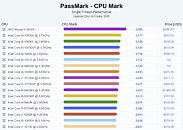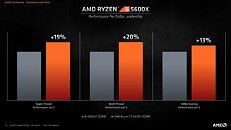Friday, October 23rd 2020

AMD Ryzen 5 5600X Takes the Crown of the Fastest CPU in Passmark Single-Thread Results
AMD has been improving its Zen core design, and with the latest Zen 3 IP found in Ryzen 5000 series CPUs, it seems like the company struck gold. Thanks to the reporting of VideoCardz, we come to know that AMD's upcoming Ryzen 5 5600X CPU has been benchmarked and compared to other competing offerings. In the CPU benchmark called PassMark, which rates all of the CPUs by multi-threaded and single-threaded performance, AMD's Ryzen 5 5600X CPU has taken the crown of the fastest CPU in the single-threaded results chart. Scoring an amazing 3495 points, it is now the fastest CPU for 1T workloads. That puts the CPU above Intel's current best—Core i9-10900K—which scores 3177 points. This puts the Zen 3 core about 10% ahead of the competition.
As a reminder, the AMD Ryzen 5 5600X CPU is a six-core, twelve threaded design that has a base clock of 3.7 GHz and boosts the frequency of the cores to 4.6 GHz, all within the TDP of 65 Watts. The CPU has 32 MB of level-3 (L3) cache and 3 MB of L2 cache.
Source:
VideoCardz
As a reminder, the AMD Ryzen 5 5600X CPU is a six-core, twelve threaded design that has a base clock of 3.7 GHz and boosts the frequency of the cores to 4.6 GHz, all within the TDP of 65 Watts. The CPU has 32 MB of level-3 (L3) cache and 3 MB of L2 cache.



141 Comments on AMD Ryzen 5 5600X Takes the Crown of the Fastest CPU in Passmark Single-Thread Results
12 and 16 cores are really only relevant for those who run specific workloads which scales beyond 8 cores. Don't get fixated on synthetic benchmarks or benchmarks which are not relevant to you.Quite on the contrary; single threaded performance is more important than ever, and is after all the base scaling factor for multithreaded performance.
Single threaded performance also helps "everything", while more cores only helps certain workloads.
They cannot control what users do!!!
The weighting can be found on their forums.
The baselines for each model can be found easily.
Baseline URL.
This is one of the results of a 10600K used for an aggregate which is what you see, Clearly states it turbo'd to 4.8 ghz.
8700k on 2017 was really a good cpu for the time.
Desktops have more cooling so you can turbo for longer and you have a bigger T delta allowing for slightly higher frequencies.
Tigerlake is atleast some breath of hope..
Tiger Lake will pull around 54W PL2 for a short time, like 30s, then pull back down to sustained power draw PL1 = 28W. Cinebench is not a short benchmark, so you are talking about a chip that draws around or less than half the power of the 65W TDP 5600X. And it scored within 1% on single thread Cinebench of that 5600X. Hence my comment.
To that point, the Ryzen 4900HS in the Asus Rog G14 - the flagship high performance model for the Ryzen, probably about the fastest you could get 3 months ago - got smoked by in an Ars review of the Tiger Lake based MSI Summit.
The applications are thread-count starved - we all need more cores because we are always limited by the speed of execution of a single thread, the only way to overcome this limit is to use more cores.
Oh, and to be honest - this PassMark thread is heavily AMD optimised.
Next time try with Microsoft Office, Adobe Photoshop, WinRar compression, Super Pi and other beautiful benchmarks where AMD CPUs get slaughtered.
Anyone know where I could buy a 128 core processor to improve my computer's performance by 3000%?
You should think of single threaded performance as performance per core, because that's what it really is, and forms the theoretical upper limit of multithreaded scaling; cores * performance per core.
All workloads split over multiple cores will encounter diminishing returns with increased core count, as synchronizing more cores is inevitably going to take more time. This overhead might not be significant if you're doing a large batch job that takes minutes or even hours, but if it's an interactive application or a game, then you have a very critical time limit before the application becomes laggy and non-responsive. Since there is an overhead cost with each thread you synchronize, balancing how threads share data and the size of work chunks is essential for good multithreaded performance. In such cases faster cores will lead to better utilization and less stalls and lag, essentially you can scale to more cores before performance gains become negligible.
As I said in my previous post, single threaded performance helps "everything". Whether an application uses 1 or 128 threads, an increase in single threaded performance is nearly always going to benefit a computational workload, and sometimes even help multithreaded performance even more due to less overhead.If an application is in fact starved for more threads, then more threads are good.
But applications have to be carefully designed to scale well. Large batch jobs are "easy", while applications like Phoshop etc. are harder. That's why you often see with such applications that more cores helps a little up to a point, but faster cores always help.
Unless an application benefits from thread isolation (which some web server tasks do), faster cores are always going to perform better than more cores. If you have the option between a CPU that has 50% more cores or one that's 50% faster per core, the latter will nearly always win.Typical rookie mistake.
There are really no such thing as "AMD optimized" or "Intel optimized".
Just because a piece of software is performing better on one specific piece of hardware, doesn't mean it's "optimized" for it. In 99.9% of cases it simply comes down to the resource balance. The exception are the few cases where unique ISA features are utilized, or the application intentionally runs a slower code path for certain hardware.
Rocket lake is going to be the juice king. 5GHz all core around 320W in cinebench like loads, prime95 will be higher.
In short Intel has turned from an indisputable x86 performance leader to something else entirely and AMD has quickly seized the opportunity to significantly increase their prices. An entry level Ryzen 5000 CPU, Ryzen 5 5600X, is now 50% (!) more expensive than its Ryzen 3000 counterpart, Ryzen 5 3600. There's nothing to be excited about. One struggling monopoly has been replaced by another.
Intel has done this to it self because it was sitting on the big throne for years and didn’t do anything really to innovate the consumer market. Only trying to get user’s money. I guess you liked paying for an i7 and get an i3 all those years.
The 5600X is not an entry level CPU. A CPU that out performers all previous Zen CPUs and most probably Intels also on single thread and match a lot of middle parts with maybe more cores, even Intels, in multi thread, for 300$...
5600X is not replacing 3600nonX
Core count does not determine level of products. Performance does.
Thank fully AMD has now offerings that shifted the entire market and Intel has woken from the eternal sleep and trying put its act/sh1t together, unlike you...
So before you say anything about a +50$ in price for top line products remember how Intel cut 500$ to try to match AMD’s
You would still pay 1000$ for 500$ CPU.
So keep your act and shit together and to your self...
We don’t need that here.
The 5600X is an entry level CPU as AMD hasn't yet announced anything cheaper/simpler. And it's not just $50 more expensive, it's $100 more expensive, or 50%. If Intel had done anything like that for their entry level CPUs people would have torn them apart! And being marginally faster in lots of workloads than Sky Lake from 2015 allows them to dictate insane prices? I don't want to participate in this discussion any longer. It's just dirty. One corporation ripping off it's customers while offering the highest performance? Bad, bad, bad! An underdog now ripping off their customers by offering the highest performance? That's totally OK. F it.
Just like previous generations, we can expect a 6c12t 5600 non-X (likely in the $230 range), a 6c6t or 4c8t 5500(X), and so on.
Beyond that, while there is a smidgen of truth to what you're saying, you're twisting it way past what's reasonable. Some issues:
-Zen 2 already surpassed Skylake and its derivatives in terms of IPC, beating them by ~7% in AnandTech's testing. Latency-sensitive workloads like gaming was one area where Intel still had the upper hand, but it was also the only area.
- Intel is already hitting >5GHz on 14nm, so saying their 10++ node allows for 4.8GHz is ... a bit weird? You're also skipping over the fact that Ice Lake improved IPC over Skylake by ~18%, which Tiger Lake carries forward (though with much improved clocks thanks to the improved 10++ node), both of which Zen 3 should now handily surpass again. So Zen 3 isn't surpassing an architecture from 2015, but one from 2020.
- Intel's issues don't just stem from their messed up 10nm node, but also their architectural development plans and their failure to improve upon Skylake for far too long when they knew 10nm wasn't panning out. (And especially that it took them five years to backport a newer core design to 14nm.)
As for saying "One struggling monopoly has been replaced by another" - please come back in five or more years. Taking a leading market position (which AMD still doesn't have, just to be clear), does not make you a monopolist. Far from it. Your arguments here are ridiculously simplistic.
I understand your frustrations regarding the higher prices, but there's also reason behind that. AMD has sold themselves as the value option with Ryzen 1000-3000. Now, with Ryzen 5000, they see no reason to present themselves that way, instead selling themselves as the overall performance champion. Thus they have no reason to price themselves lower than Intel - the value comes with the better performance, not the lower price. Does this suck for end users now accustomed to cheap many-core CPUs from AMD? Of course it does! But it is nowhere near a reasonable threshold for being called a ripoff. You're getting your money's worth, after all. It's not like they are returning to $400 4c8t CPUs like we had before Ryzen...
-
The Core i3 6100, much faster in single-threaded mode than anything from AMD at that time was sold for $117.
The Core i3 4130 before it, $122.
Why didn't Intel sell the Core i3 6100 for $183? It was the fastest entry level CPU at that time!
Double effing standards and hypocrisy from AMD fans all the effing time even when their idol starts ripping off (Ryzen 5 3600 $200, Ryzen 5 5600 with the same number of cores $300).Even the most evil company in the world, Intel, didn't allow itself to do that as indicated earlier. F it and I'm out.
Speaking of monopolies. Yes, AMD is playing like a monopoly. They've got the highest performance and they've started dictating prices which indicate they have no competition. Again, refer to my example at the beginning of the post: Intel did not allow itself to increase prices between generations for similar products, except when they started to offer significantly more cores. AMD has increased the price of their entry level CPU by whopping 50%, not $50 you keep mentioning.
Are we in kindergarden here?
The 1600/2600/3600/5600 is the entry level CPUs of AMD... Right...!!!
And the 1200/1300/1400/1500/3100/3300 what exactly are? Sub-entry level or non existent CPUs?
You can cry all you want. 5600X is replacing 3600X and has price bump of 50$. That is a +20% on MSRP with at least the same performance uplift and most probably performs faster than any 6core.
Please... you can try harder than this.